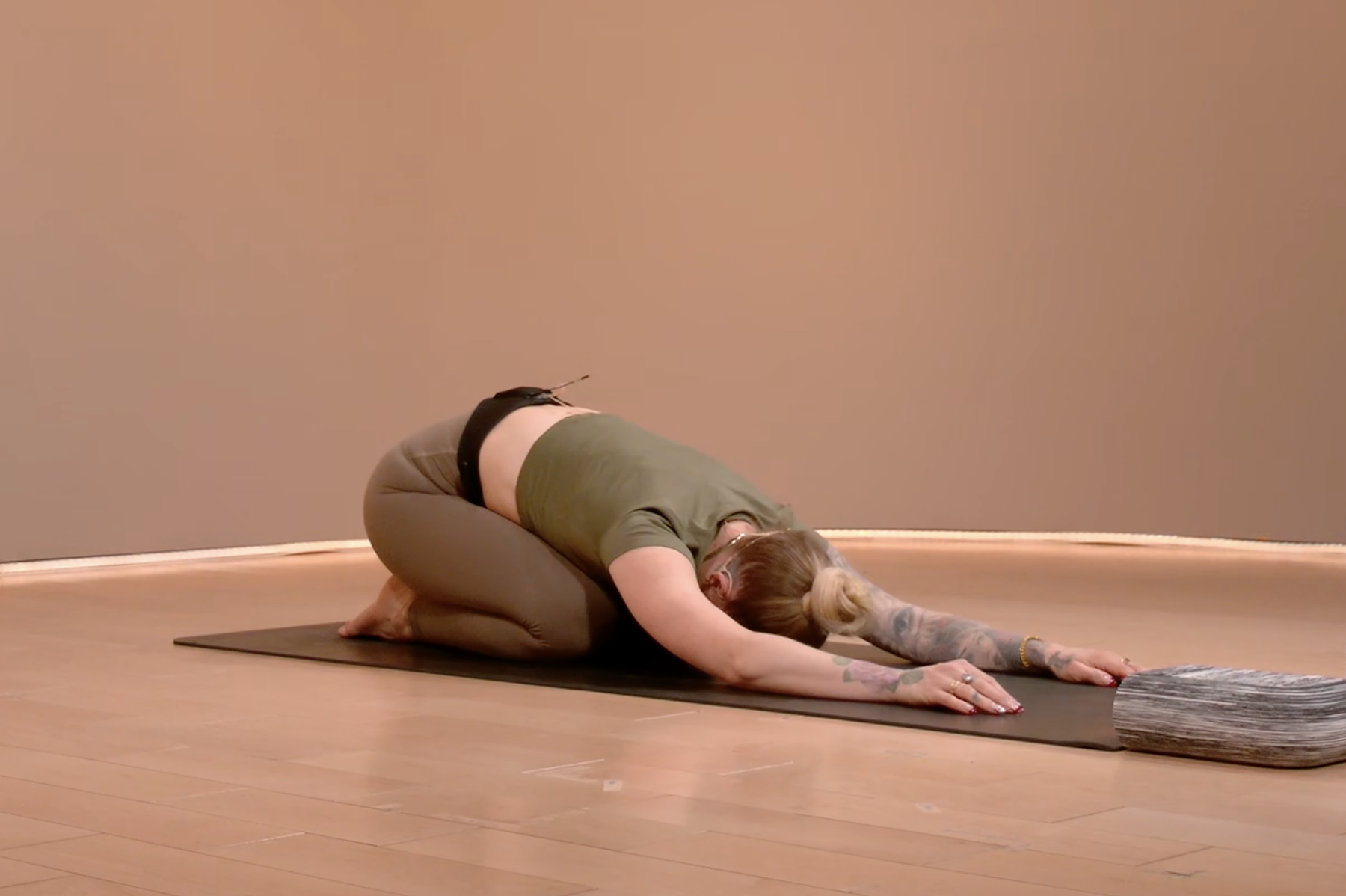
Westend61/Westend61 via Getty Images
Tight Back Muscles? Try These 6 Stretches for Looser Lats
These lat stretches can help relieve a tight back after a tough workout.
By Jennifer Heimlich•
The Lats Muscles, Explained
What Causes Tight Lat Muscles?
The Benefits of Doing Lat Stretches
The 6 Best Lat Stretches
Yoga Moves That Stretch the Lats
How to Add Lat Stretches to Your Routine
At the end of a long day, you raise your clasped hands overhead in a big yawn, and—ouch! You suddenly realize that your back is in desperate need of some good lat stretches. Officially called the latissimus dorsi, these large muscles spanning the middle and lower back can get tight and achy when we forget to give them a little love.
Discover more ways to reach your goals with Peloton
But despite taking up a huge portion of our torso, the lat muscles can be surprisingly tricky to stretch. Here’s what you need to know when you’re looking to learn how to stretch your lats.
The Lats Muscles, Explained
The lats are major muscles that lie flat along the back, traveling from the middle (just below the shoulder blades) all the way down to our low back. “Primarily, they're responsible for a climbing motion, pulling yourself up,” says Eric Lehman, DPT, a physical therapist with the Cleveland Clinic. He adds they also help to stabilize the spine. So you’ll feel them if you do an intense rowing workout or a strength session that calls for moves like pull-ups.
What Causes Tight Lat Muscles?
Peloton instructor Adrian Williams says that tight lats can be caused by a variety of factors, including daily habits, posture issues, and mobility issues. Your workouts can also lead to tight lats if you overdo exercises that challenge them or use improper technique—especially if you forget to warm up beforehand or neglect your stretching and mobility work, says Adrian.
Lehman adds that many of us simply don’t use the movements that activate and stretch the lats very often in daily life, so these muscles get tight and weak. “Not a lot of individuals expose themselves to overhead motions,” he says. Unless you’re a professional painter or climb trees for fun, this is where workouts come into play to make sure your lats stay healthy.
The Benefits of Doing Lat Stretches
A solid lat stretching routine can offer plenty of perks. As Adrian explains, more flexible and pliable lats can increase the mobility in your shoulders and the mid part of your spine, also called the thoracic spine. This can reduce your risk of strains or injuries in this area. “Because I like to train full body quite a bit, [these stretches] help range of motion in the shoulders, back, and torso. Tight lats can also lead to bad posture. Releasing any tension in the lats will help you maintain a more upright position and reduce strain potentially in the neck and lower back” says Adrian.
You won’t just feel it in your workouts, but also in everyday life. Because if you don’t have enough mobility in your lats, you might struggle to reach overhead. “There are certainly things that life asks of us, whether it's something light like reaching into the cupboard, or something a little bit heavier like lifting something onto a high shelf or playing with a child and throwing them overhead,” Lehman says. “Enjoying that improved mobility is just going to lead to more efficiency and then less likelihood of shoulder pain or discomfort.”
And if you’re an athlete who uses overhead motions, like a volleyball player, or a rock climber, that mobility is essential. “When you have a limited range of motion, it's going to limit your ability to really take advantage of torque,” Lehman says. “You're not going to be able to take that arm back as far and won't be able to produce as much force.”
The 6 Best Lat Stretches
So, what are the most effective ways to stretch these muscles? Here are the top lat stretches that Adrian and Dr. Lehman recommend.
Dynamic Lat Stretch with Arm Swings
Adrian suggests this dynamic stretch to get those lats loose and moving as part of a warm up before a workout.
1. Stand with your feet shoulder-width apart.
2. Swing one arm in a large circle, starting from in front of you, then overhead, and back behind you.
3. Switch directions and repeat.
4. Perform 10 to 15 swings per arm.

Cat-Cow Stretch
This dynamic lat stretch is a great way to warm up your back and open up your range of motion in the spine.
1. Start in a table-top position on all fours.
2. Arch your back (cow pose) and look up.
3. Then, round your back (cat pose) and tuck your chin in toward your chest.
4. Perform 10 to 15 cycles.

MixMedia/E+ via Getty Images
Standing Side Reach
This standing stretch may look simple, but it’s effective.
1. Stand with your feet shoulder-width apart.
2. Reach one arm overhead and lean to the opposite side, stretching the side of your body.
3. Alternate sides, completing 10 to 15 repetitions.

Overhead Lat Stretch
This version of the classic triceps stretch can get into the lats, too.
1. Stand with your feet shoulder-width apart.
2. Raise one arm overhead, bend the elbow, and grab it with the opposite hand.
3. Gently pull the elbow towards the opposite side, leaning towards that opposite side until you feel the stretch in the lat.
4. Hold for 30 to 60 seconds, then switch sides.
Resistance Band Lat Stretch
Lehman recommends doing this passive stretch using resistance from a pull-up bar after a tough workout.
1. Loop a strong resistance band around a pull-up bar, and grab it with your right hand, turning the palm up.
2. Walk back away from the pull-up bar and sit back into a squat until the band is taut.
3. Lean your middle back away from the band and shift your shoulders a little to the left until you feel a stretch in the right lat.
4. Repeat on the other side.
Overhead Mobility Test
Lehman likes to use this move to see if tight lats are messing with your shoulder mobility.
1. Lie down on the floor with your knees bent and feet flat on the ground. Hold onto a stick like a PVC pipe or broomstick, gripping it overhand with both hands.
2. Slowly raise the stick up overhead and lower it down behind your head, trying to touch the backs of your hands to the ground without lifting up your lower back.
3. Repeat.
Yoga Moves That Stretch the Lats
Yoga can also be a great way to get into those lats. Although Adrian doesn’t teach yoga himself, he says there are a few poses he relies on regularly to keep his own lats open and loose. “I am not a yogi but there are few that I can recall that have worked well for me and that I use in my day to day life—Downward-Facing Dog, Extended Puppy Pose, and Child’s Pose,” he says.

Downward-Facing Dog
A yoga staple, Downward-Facing Dog gets the arms overhead in an upside-down position to hit the lats from a new angle.
1. From an all-fours position, tuck your toes and extend your knees to lift your hips into the air, making an inverted “V” shape.
2. Bend your knees if you need to in order to make a straight line from your wrists to your hips. You can also pedal out the feet and move your hips from side to side if that feels good (it might help you get further into the lats).
3. Stay in this position for 30 to 60 seconds, working towards straightening your legs and lengthening the heels toward the ground.

LordHenriVoton/E+ via Getty Images
Extended Puppy Pose
This move is like a mini–Downward Dog, with a similar upper body position but the knees on the ground.
1. Start in a table-top position on all fours.
2. Walk your hands forward and lower your chest towards the ground, keeping your hips over your knees.
3. Hold for 30 to 60 seconds.

Child's Pose with Lat Stretch
As a passive lat stretch, Child’s Pose is an ideal recovery move.
1. Start kneeling, with your hips sitting back on your heels. Open the knees wide enough to leave room for your torso to sink toward the ground between your thighs.
2. Reach your arms forward with hands on the floor, extending in front of you as far as you can.
3. Walk the hands toward the upper right corner of the mat until you feel a stretch in the left lat.
4. Hold for 30 to 60 seconds, then repeat on the other side.
How to Add Lat Stretches to Your Routine
There’s never a bad time to stretch out the lats. Adrian suggests beginning your day with a short routine that includes lat stretches to open up your back.
Then, throughout the work day—particularly if you have a desk job—he recommends taking short stretch breaks every hour or so. This can help counteract prolonged sitting, especially if you naturally settle into not-so-ergonomic postures.
Of course, lat stretches are a great thing to do when you get your sweat on, particularly if you’re working out those back muscles.
And if your lats are feeling too twitchy to let you fall asleep comfortably at the end of the day, Adrian suggests doing a few passive lat stretches like Child’s Pose before getting into bed.
Really, the best time to stretch is whenever your body is asking for it.

Peloton App
Access thousands of classes with no equipment needed.
This content is for informational and educational purposes only and does not constitute individualized advice. It is not intended to replace professional medical evaluation, diagnosis, or treatment. Seek the advice of your physician for questions you may have regarding your health or a medical condition. If you are having a medical emergency, call your physician or 911 immediately.
Level up your inbox.
Subscribe for a weekly dose of fitness, plus the latest promos, launches, and events.
By providing your email address, you agree to receive marketing communications from Peloton.
For more about how we use your information, see our Privacy Policy.





